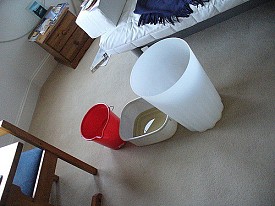How to Find a Roof Leak (So You Can Get it Repaired!)
 Even a small roof leak can result in serious damage to your home's structure, as well as wasting substantial amounts of water. What's more, it may lead to mold growth, which is hazardous to human health. Find the source of your leaky roof and take care of the necessary roof leak repair fast before it ends up costing you a bundle of cash and aggravation.
Even a small roof leak can result in serious damage to your home's structure, as well as wasting substantial amounts of water. What's more, it may lead to mold growth, which is hazardous to human health. Find the source of your leaky roof and take care of the necessary roof leak repair fast before it ends up costing you a bundle of cash and aggravation.
Signs of a Leak
The sound or sight of dripping water is an obvious indication of a trouble spot. However, it may not be quite that easy to detect. If you have any hint of a leak in your roof, you might need to do some in-depth investigative work. Suspicious signs include a ceiling, wall, or floor which has wet, stained, or discolored patches; unexplained bulges; or peeling paint. Alternatively, you could smell a musty odor in the vicinity.
Look in the Attic
The next step, if you have access to the attic, is to try going up there -- armed with a flashlight if necessary -- to have a good hard look around. Chances are that the water stains will be even worse in the attic than on your ceiling and will help you locate where the leak is allowing liquid to penetrate. You may even spy evidence of mold.
Check Out the Roof
After that, ask a partner to wait inside the house while you take your garden hose and climb up on the roof. Estimate where you think the roof leak might be coming from and spray that area with the hose. Continue to experiment with spraying various spots, one at a time. Have your helper call you when water starts coming through to where he or she is stationed down below.
Check Dormer Walls While You're at It
A "roof leak" may actually originate in a wall. Check any dormer walls for cracks or rot that may be allowing water in.
Tear off Shingles
If you still have not pinpointed exactly where the roof leak is, it's time to take a more drastic measure. Start removing roof shingles in the general area of leakage. This should reveal water stains and rot in the immediate vicinity of the water source.
Determine the Cause
Now you have located the place, you're ready to find out the cause. The leak may be due to improper sealing around a structure atop your roof, such as a chimney or dormer window. Roof vents are another common culprit; metal ones may develop breaks in their seams, while plastic vents are subject to cracked housings. Rusted flashing could also be at fault. Your problem might even be as simple as actual holes in the roof, especially in an older home. A previous owner may have installed -- and removed -- a satellite dish or other equipment, without adequately filling the holes left behind.
Repair the Roof Leak First, Then Deal with Any Mold
Friends and acquaintances may advise you to try cleaning up the mold or to have it remediated before taking any other action. However, this is unsound advice. When mold in your home results from dampness seeping in through the roof, it will recur unless and until the source of the moisture itself, that is, the leaky roof, has been repaired. Contact a roofing contractor to repair your roof leak as soon as possible; only then should you start dealing with the mold situation.
Contact Your Insurance Company
For serious mold problems, you may be eligible for compensation according to your homeowners insurance policy ... or not. Many insurers state that mold caused by a leaky roof is a problem that developed over an extended period of time, and one which you could have prevented with proper vigilance -- that is, regular inspections of your roof. Still, it may be worth filing a claim.
Laura Firszt writes for networx.com.
Updated September 2, 2018.
Looking for a Pro? Call us (866) 441-6648

Roofing Average Costs
Roofers Experiences

Come See My New Metal Roof! It Is Fantastic!

Gutter Replacement By A Contractor Who Cares About Customer Satisfaction



